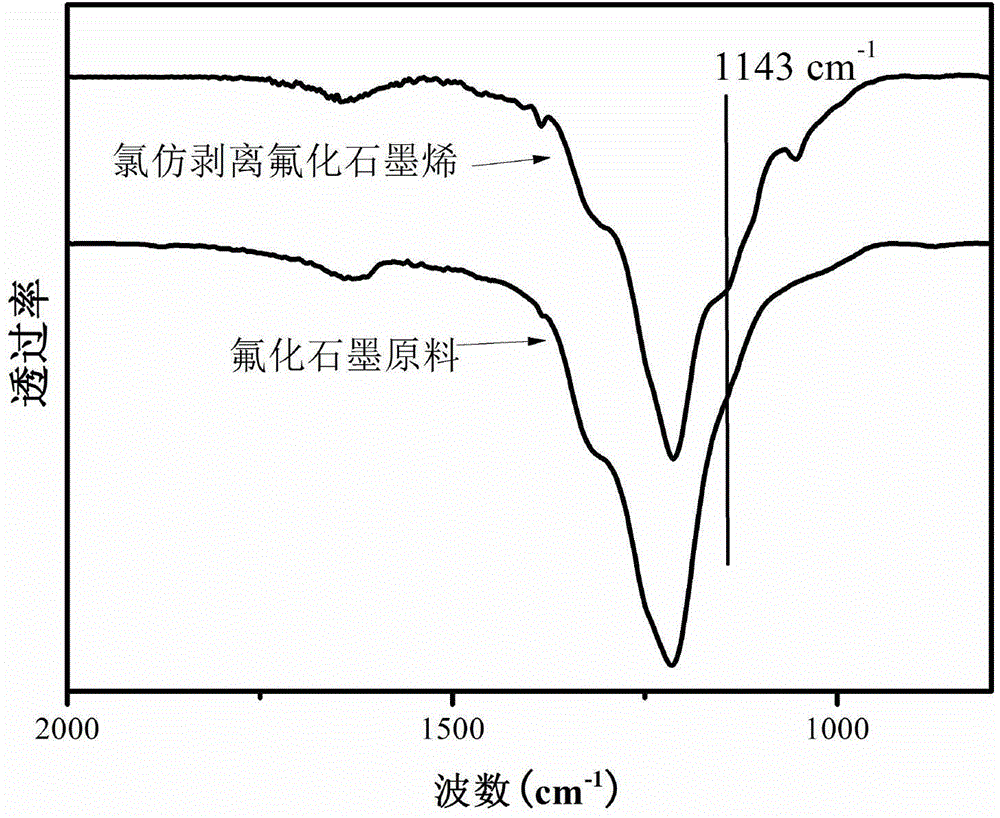Fluorinated graphene containing semi-ionic C-F bonds and secondary sodium battery adopting the fluorinated graphene as the cathode
A technology of fluorinated graphene and fluorinated graphite, applied in secondary batteries, battery electrodes, circuits, etc., can solve problems such as poor power characteristics, battery expansion, low ion transmission characteristics, etc., achieve good cycle characteristics and realize recycling Effect
- Summary
- Abstract
- Description
- Claims
- Application Information
AI Technical Summary
Problems solved by technology
Method used
Image
Examples
Embodiment 1
[0029] Weigh 20 mg of fluorinated graphite and add it to 100 mL of chloroform, stir at a constant speed for half an hour to disperse the fluorinated graphite in chloroform, then add it into a stainless steel reaction kettle, put the reaction kettle into a muffle furnace, and heat at 150°C for 12 hours. After the end, the resulting suspension was ultrasonicated for 6 hours, and then the ultrasonicated suspension was centrifuged at a speed of 500r / min for 30 minutes to remove the unreacted solids in the lower layer, and the resulting solution was suction-filtered to obtain a filter cake, which was heated at 60°C Under drying, obtain fluorinated graphene material, through X photoelectron energy spectrum analysis wherein the proportion that C-F semi-ionic bond accounts for is 16.7% (that is, in the XPS spectrogram, the integral area corresponding to the peak of C-F semi-ionic bond is the same as the corresponding C-F Semi-ionic bond, corresponding to C-F covalent bond, correspondin...
Embodiment 2
[0031] Weigh 50mg of fluorinated graphite and add it into 100mL of chloroform, stir at a constant speed for half an hour to disperse the fluorinated graphite in chloroform, then add it into a stainless steel reaction kettle, heat at 120°C for 10h, after the heating time is over, ultrasonicate the obtained suspension for 8h, Then the supersonic suspension was centrifuged at a speed of 1000r / min for 30min to remove unreacted solids, and the resulting solution was suction-filtered to obtain a filter cake, which was dried at 60°C to obtain a fluorinated graphene material. Characterized by X-ray photoelectron spectroscopy, the proportion of C-F ionic bonds is 12.3%. Weigh fluorinated graphene, acetylene black and PVDF with a mass ratio of 78:12:10, place them in NMP for wet grinding to prepare a uniform slurry. Spread the ground slurry evenly on the aluminum foil, place it in a blast oven and bake at a certain temperature for 1-2 hours. The baked material was placed in a vacuum ov...
Embodiment 3
[0033] Weigh 60 mg of fluorinated graphite and add it to 100 mL of chloroform, stir at a constant speed for half an hour to disperse the fluorinated graphite in chloroform, then add it into a stainless steel reaction kettle, put the reaction kettle into a muffle furnace, and heat at 90°C for 12 hours. After the end, the obtained suspension was ultrasonicated for 10 hours, and then the ultrasonicated suspension was centrifuged at a speed of 1500r / min for 20 minutes to remove the reacted solids, and the obtained solution was suction-filtered to obtain a filter cake. After drying, the fluorinated graphene material was obtained, and the proportion of C-F ionic bonds was listed as 8.9% through X-ray photoelectron spectroscopy. Weigh fluorinated graphene, acetylene black and PVDF with a mass ratio of 82:8:10, place them in NMP for wet grinding to prepare a uniform slurry. Spread the ground slurry evenly on the aluminum foil, place it in a blast oven and bake at a certain temperature...
PUM
 Login to View More
Login to View More Abstract
Description
Claims
Application Information
 Login to View More
Login to View More - Generate Ideas
- Intellectual Property
- Life Sciences
- Materials
- Tech Scout
- Unparalleled Data Quality
- Higher Quality Content
- 60% Fewer Hallucinations
Browse by: Latest US Patents, China's latest patents, Technical Efficacy Thesaurus, Application Domain, Technology Topic, Popular Technical Reports.
© 2025 PatSnap. All rights reserved.Legal|Privacy policy|Modern Slavery Act Transparency Statement|Sitemap|About US| Contact US: help@patsnap.com



